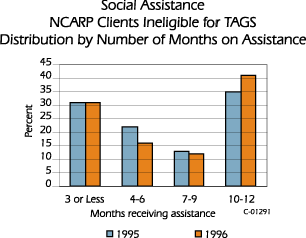| 7.0
Social Assistance The TAGS program has provided income support for a large number of workers displaced from the fishing industry. A key question is: How many TAGS clients might be expected to require Social Assistance as the program expires? This is an important issue since it does not appear that the fisheries will be operational to an extent where all displaced workers can return to work as TAGS support ends. It is always difficult, and often impossible, to predict future economic events with precision and this is certainly the case with regards to estimating the potential SA needs of TAGS clients. Many factors interact to ultimately determine whether or not individuals will need SA. Events within the industry, choices of individuals such as whether or not they will leave the Province to search for work, the status of the economy at a future time and other issues all play a part in determining what can be expected to unfold. Because of factors such as these, the advance assessment of possible SA need is confounded. Also, fisheries workers have historically not had an extensive reliance upon SA and thus an extensive future requirement will represent a newly emerged situation rather that a potential continuation of a previously established trend. The best indications of what might be expected in the future may be determined from what has been experienced by clients who no longer collect benefits from the program. One such major group are NCARP clients who were not accepted into the TAGS program and thus received no income support after December 1994 (see chart below). For the most part, this group (some 3,000 persons) were most strongly attached to non-fisheries labour markets. |
|||
 Of the 3,000, approximately 24 percent were a member of an SA case which received benefits in 1995 and 21 percent in 1996. During 1995 and 1996 about 30 percent of these individuals belonged to a case which received benefits for three months or less and some 70 percent received benefits for less than a year. The diagram shows the distribution of clients by number of months on assistance in 1995 and 1996. It indicates that in 1996 a larger proportion of clients collected benefits for a greater number months than than was the case in 1995. In May 1996, 1,470 individuals who had been eligible for TAGS exhausted their benefits. During the twelve months that followed, the proportion that requested SA was not significantly different from what was observed for those who left the program in 1994. About 23 percent of the individuals were SA recipients during the twelve month period. It remains to be seen whether or not other aspects of their SA attachment will be similar to the 1994 group. Data required to compare the two groups will not be available until the fall of 1997. Most of those who have exited the TAGS program have not accessed SA. Analysis indicates that some of those who have exited TAGS live in households which have other family members eligible for either TAGS or EI or are employed in the labour market. This would have the effect of diminishing the need and/or eligibility for SA. Also, as was described elsewhere, many TAGS clients have had attachment to the labour market both during and since their eligibility for TAGS. These workers have not found it necessary to seek income support from the Province's Social Assistance program to offset the income no longer available from TAGS. Since the nature and characteristics of those who are currently eligible for TAGS may differ from the groups referred to above, it remains to be seen whether or not the statistics accurately foretell what will be experienced by future TAGS exhaustees. |
|||